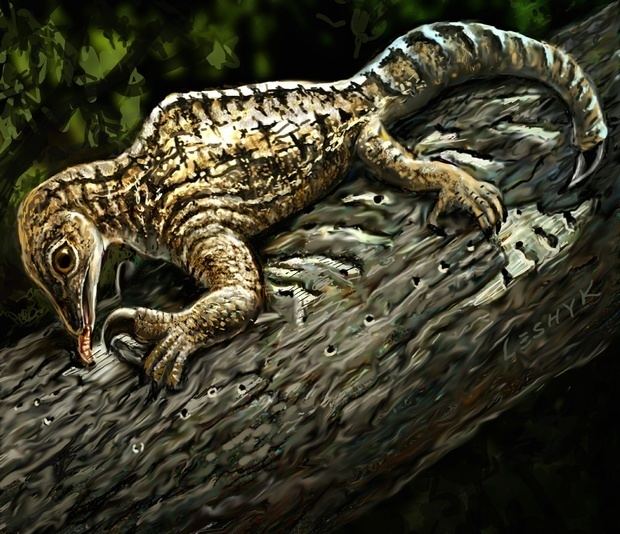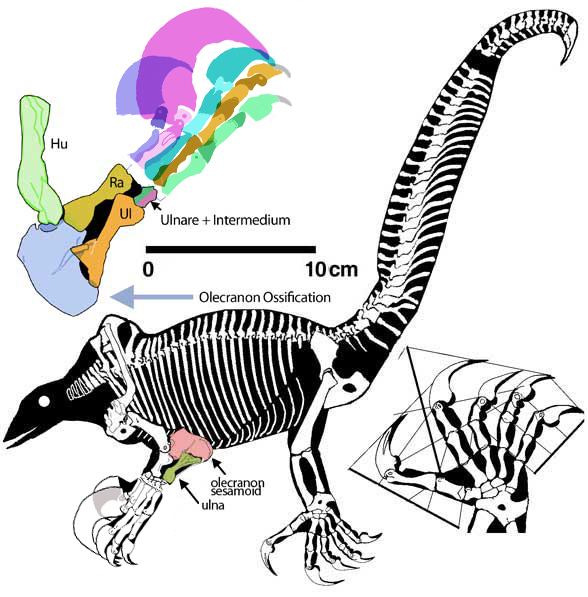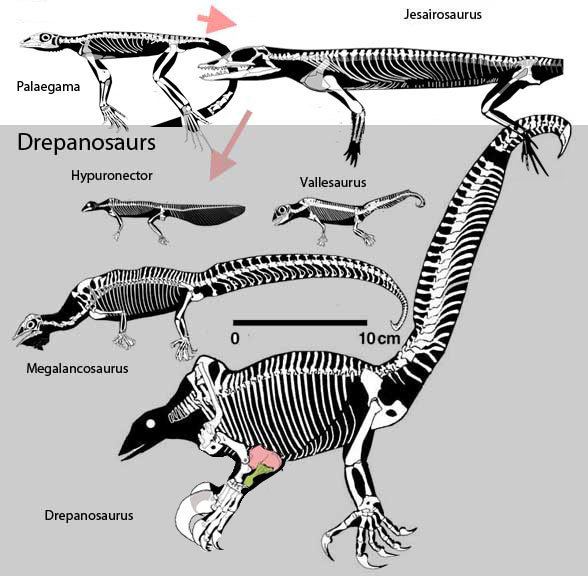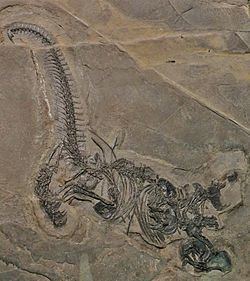Family †Drepanosauridae Phylum Chordata | Class Reptilia Species †D. unguicaudatus Rank Genus | |
 | ||
Similar | ||
Paleo profile drepanosaurus
Drepanosaurus (Dre-pan-o-sore-us) is a genus of arboreal (tree-dwelling) reptile that lived during the Triassic Period. Drepanosaurus is a genus of Drepanosauridae, a group of diapsid reptiles known for their prehensile tails. Only one adult Drepanosaurus specimen and two immature specimens have ever been found and all lacked a head and neck. Drepanosaurus was probably an insectivore, and lived in a coastal environment in what is now modern day Italy, as well as in a streamside environment in the midwestern United States.
Contents

Description
A full sized adult Drepanosaurus had a length of about half a meter or 45 to 50 cm.

In general, all drepanosaurs can be characterized as having long, gracile necks with a lightly built triangular skull that superficially resembles those of birds. They also have heavy bodies, with fused vertebrae up into a ridge over their shoulders. Their limbs can be described as chameleon-like with grasping hands and feet. Their long tails are tall and narrow with the possibility of containing a tail tip that has been modified into a claw.

Drepanosaurus is known to have a huge claw on the index finger of each hand along with the tail claw. The skull of Drepanosaurus has never been found and is still unknown, however, the skulls of other drepanosaurs like Megalancosaurus give us an idea of what the skull of Drepanosaurus might look like. Looking at Megalancosaurus's skull shows that the claws of each index finger were probably the size of the entire head of Drepanosaurus and a bird like jaw and head shape.
The forelimb of Drepanosaurus is highly modified compared to other vertebrates and very robust. Its ulna was altered from being a forearm bone into an odd crescent shaped site for muscle attachment. The role played by the ulna in most tetrapods is replaced by an elongated carpal bone. Additional musculature would be attached to the high withers that characterized Drepanosaurus and its close relatives.
A clue to the purpose of these large muscles can be found on its hand. The animal's "index finger" bore a large claw reminiscent of those born by dinosaurs such as Noasaurus and Baryonyx. However it is more likely that Drepanosaurus used its claw like the modern pygmy anteater, tearing through bark and insect nests to find invertebrate prey. Some researchers have forwarded the more far-fetched proposal that the claw was used to excavate burrows, but this is not unanimously agreed upon.
The dorsal neural spine humps of Drepanosaurus are much taller along all succeeding spines reaching down to the sacrum. Sacral and anterior caudal neural spines are very low if present at all and neural spines are elongated showing expanded dorsal margins after those areas. The scapula was robust with a 70 degree bend. The humerus and radius were short while the ulna was replaced by an ulnare and shifted to the elbow taking a disc-like form. This skeletal configuration change is thought to have been from the large claw on digit II requiring a large muscle in order to operate. The pelvis was large with the pubis forming the majority of the ventral portion. The hind limbs of Drepanosaurus were much larger than the forelimbs with the tibia and fibula being broadly separated.
Discovery and classification
Discovered in northern Italy in 1979, Drepanosaurus was named by Giovanni Pinna, a Professor in Paleontology and museologist. Drepanosaurus is a rare fossil and the one adult specimen found is incomplete. Another partial specimen of Drepanosaurus was found in New Mexico's Chinle Formation in 2016. Drepanosaurus is part of the clade Drepanosauridae, which is nested in the larger clade Drepanosauromorpha. Drepanosauromorphs are sometimes considered part of the group Protorosauria which may or may not be a natural group (i.e., monophyletic). In any case, it is clear that drepanosaurs are diapsid reptiles. The species name is Drepanosaurus unguicaudatus.
Its name is Greek for "sickle lizard".
Diet
Drepanosaurus is hypothesized to have been an insectivore, using those large claws on the second digits to lift bark and dig into crevices and grooves on trees to find insects. It is considered that Drepanosaurus was also a digging animal and could use the tail as a tool for unearthing insects. Concerns about whether Drepanosaurus's tail was flexible enough to be used for digging are still brought up today, especially since many characteristics point to Drepanosaurus being primarily a tree-dwelling animal.
Paleoecology
Being only 45 to 50 cm in length, Drepanosaurus spent its time in trees using its gripping chameleon-like hands and feet to climb from branch to branch as well as its long tail to help wrap around branches. This hypothesized behavioral characteristic brings the notion of "monkey-like" to Drepanosaurus. The tail also provided extra support along with the claw at the tip to help grip branches. Drepanosaurus would be found in wooded environments and ecosystems in what is now present day Northern Italy. Relatives have been found in other parts of Italy and New Mexico and New Jersey as well, in similar woodlands. Drepanosaurus is much larger than its relatives, more than double the length of Megalancosaurus. All drepanosaurs are thought to be tree-dwelling insectivores with similar body structures to Drepanosaurus, except for minor differences usually dealing with forelimb configuration and head shape disparities.
